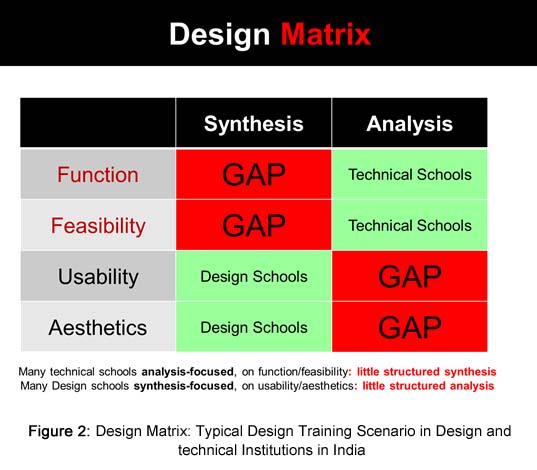
Design in Innovation : How Should We Train Future Innovators?
By : Amaresh Chakrabarti

Innovation starts and ends in the society. The innovator finds issues and opportunities in the society to resolve or fulfil, develops solutions and offerings to resolve the issues, and delivers these to the society. Knowledge of society, therefore, is a significant part of the repertoire that an innovator must have.
Innovation develops, integrates and uses technology to find and solve problems and deliver solutions. It comes from multiple domains. Technology is a way of achieving an effect (e.g. a material with piezo-electric property), that comes from a variety of domains e.g. semiotic, engineering, usability, etc.
Innovation must satisfy all stakeholders in the product’s lifecycle. There must be incentive for every provider to implement its phases of the lifecycle (manufacture, deliver, service and retire the product), and users must be ready to pay for these, i.e. it much be an economic win-win for providers and users.
All these must happen within constraints of the fragile ecology of the earth-system. Resources are finite, and ecology and humans are vulnerable, while the population grows with expanding needs. These conflicting elements must be balanced while remembering that every process in a product’s lifecycle can variously impact resource availability, health of the ecosystem and health of the human population.
Innovation must therefore integrate knowledge of the society, economy, ecology and technology so as to identify significant needs in the society, integrate technology to develop offerings that are economically and societally beneficial while being ecologically benign, and deliver these to the society.
To fulfil the needs, innovation may be required in one or a combination of these areas: product, process, services, business, and policy. What are the critical pieces of knowledge that our innovators must be trained in, so that they can innovate in an economically, ecologically and socially sustainable manner?
The key to this is design. Adapting Herbert Simon’s definition, we define a design as “a plan for intervention which, when implemented, is intended to change an undesirable situation into a (less un-) desirable one. Designing is the process of identifying these situations as well as developing designs to support the transition”.
Design is the engine of innovation. Based on our research, the following pieces of knowledge are found to be crucial for innovation, see the ‘Innovation Matrix’ in figure 1:
- Thinking: There is a generic mindset for innovation that is need/problem/opportunity-centred, and follows a style of thinking with a generic cycle of problem finding and solving that can be applied for innovation across multiple areas. In product design it is often called design thinking.
- Systematic design process: No complex system is developed without a detailed, systematic process; I would not trust an aircraft designed with intuition alone. This process has generic elements, as well as specific ones that vary with the area of innovation and system innovated.
- Science and technology: The complex and detailed process above must utilize and integrate various pieces of science and technology, i.e. building blocks, from a variety of domains: semiotics, engineering, usability, manufacturing, cost, organization, sustainability, and so on.
- Tools: Many of these processes would be impossible, hard, time-consuming or tedious to carry out without supporting methods and tools. Imagine analysing deflections of complex parts by combining by hand equations of forces and deflections for a million elements!
Innovators need to be trained in all the above types of knowledge, focusing on the specific areas of innovation of interest, so that innovators can identify the right opportunity, and develop in an efficient manner solutions that are effective. However, in typical technical or design institutions, innovation is mainly on the product, occasionally on processes of manufacturing, and rarely on services or business.
To break free of this, understanding the whole lifecycle of the product is crucial to identify opportunities for innovation. Lifecycle thinking, therefore, is a key innovation-enabler. Often the opportunity for innovation lies in areas beyond the product. For a mature product, differentiation may happen in how good the service is, and not whether the product performance can be marginally bettered. The opportunity may lie in reducing the lifecycle cost of the product, rather than its initial cost. Without lifecycle thinking, an innovator is imprisoned in the first two areas of innovation only.
Finally, design involves both synthesis and analysis. Synthesis is about diverging – exploring the multiple possible ways of interpreting and fulfilling the need. Analysis is about converging – evaluating and selecting those that reflect or fulfil the need better. What is often overlooked in training curricula is the need to combine both synthesis and analysis in the training for innovation.
Further, if the domains, that are typically considered engineering (functionality, manufacturability, cost) and non-engineering oriented (semiotics, usability, sustainability), are juxtaposed against the activities of synthesis and analysis, a ‘Design Matrix’ can be formed, see Figure 2. Analysis of the Indian scenario, using this design matrix reveals an interesting polarization.

Technical institutions seem to focus primarily on training students in analyses of engineering aspects of products and processes, with little emphasis on synthesis. In contrast, design institutions train mainly on exploration of non-engineering aspects, without much emphasis on rigorous analyses of these aspects.
Let us conclude the article with a brief recipe for training innovators in complex systems innovation:
- Cover all aspects in the Innovation and Design Matrices in Figures 1-2. Train for both engineering and non-engineering aspects, for both synthesis and analyses, in all innovation areas.
- Include open-ended projects that involve both problem finding and solving, all the way from developing products/processes to developing services/business, with implementable outcomes.
- Have implementation goals in projects, e.g. developing and user-testing of working prototypes.
- Initiate programmes for research into design and innovation; that focuses on understanding and strengthening the knowledge of how to design and innovate better, for better.
Centre for Product Design and Manufacturing (CPDM) at the Indian Institute of Science (IISc) Bangalore offers one such programme, MDes, for graduate engineers and architects. It also has an active research programme in various aspects of design and innovation, the first formal programme in India in this area.
Amaresh Chakrabarti
Professor & Chairperson
Centre for Product Design &
Manufacturing, Indian Institute of Science, Bangalore, India
